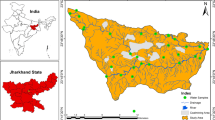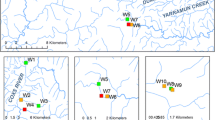Abstract
The present research makes an effort towards awareness of the impact of underground coal mining on water environment around the Barapukuria coal mining area, Dinajpur by direct field investigation, questionnaire survey and laboratory analysis. For this research, the three foremost errands have been mulled over which are the water level data analysis for 10 years from 2001 to 2011, ground water major parametric analysis and the questionnaire survey on the availability of ground water before and after coal mining operation. The results of field and laboratory analysis show that the characteristics and concentrations of all the major physical and chemical parameters such as pH, EC, Temperature, HCO3 −, NO3 −, SO4 2−, Cl−, Na+, K+, Mg2+, Ca2+ and Fe(total) are still tolerable for all purposes and also within the standard limit. On the other hand, the questionnaire survey and water level data analysis confirm almost similar results regarding the depletion of water level. The water level has depleted more than 5 m from 2001 to 2011. Therefore, currently the availability of ground water is normal in the rainy and winter seasons but is slight problematic in the dry season where ground water was available at all times prior to coal mining in the area. From these scenarios, it is comprehensible that the ground water level moves downwards than earlier because of the excess pumping of water from the mine area. Besides the natural recharge condition is not enough and somewhere breaks off while some of the mines out areas are subsided, consequently the upper part of the water bearing formations (aquifer) loses its porous and permeable properties resulting water recharging problem which is directly responsible for depleting the ground water level over the area. Moreover, the water levels will also decline relative to the location, depth, recharge, and discharge conditions of the mine both aerially and vertically while there is a typical relationship between the depth of mining and static water level which is water levels will decline more as the mine goes deeper. Therefore, taking into account the current ground water condition and the depth of Barapukuria coal mine, this research implied that the water level will deplete more in day coming and the water crisis will be more for future. Thus, this research recommends a sustainable guideline for long-term planning and also suggests that regular monitoring with time to time more detail qualitative and quantitative assessments of water bodies in the area.






Similar content being viewed by others
References
Alam M, Alam MM, Curray J, Chowdhury RMLR, Gani MR (2003) An overview of the sedimentary geology of the Bengal Basin in relation to the regional tectonic framework and basin-fill history. Sediment Geol 155:179–208
Alam JB, Ahmed AAM, Khan MJH, Ahmed B (2011) Evaluation of possible environmental impacts for Barapukuria thermal power plant and coal mine. J Soil Sci Environ Manage 2(5):126–131
Bakr MA, Rahman QMA, Islam MM, Islam MK, Uddin MN, Resan SA, Haider MJ, Sultan-Ul-Islam M, Ali MW, Chowdhury MA, Mannan KH, Anam ANMH (1987) Geology and coal deposit of Barapukuria basin, Dinajpur Districts, Bangladesh. Records Geol Surv Bangladesh 8(1):36
Bhardwaj V, Singh DS (2011) Surface and groundwater quality characterization of Deoria District, Ganga Plain, India. Environ Earth Sci 63:383–395
CMC (1994) Preliminary geology and exploration report of Barapukuria coal mine, Bangladesh
CMC (1999) Preliminary geology and exploration report of Barapukuria coal mine, Bangladesh
CMC (2012) Regularly monitoring geology and hydrology report of Barapukuria coal mine, Bangladesh
EIA (2006) Bangladesh: Phulbari Coal Project (Summary Environmental Impact Assessment), Project Number: 39933, p 132
European Union (EU) (2008) Drinking water standards. EU
Grmela A (1997) Protection of ground water resources quality and quantity in mining areas. In: Strakos V, Kebo V, Farana R, Smutny L (eds) Mine planning and equipment selection. Balkema Publishing, Rotterdam, pp 865–872
Hall GEM (1998) Relative contamination levels observed in different types of bottles used to collect water samples. Explore 101:1–7
Hoehn RC, Sizemore DR (1977) Acid mine drainage (AMD) and its impact on a small Virginia stream. Water Res. Bull 13:153–160
Hoque MA, Hoque MM, Ahmed KM (2007) Declining groundwater table and aquifer dewatering in Dhaka metropolitan area, Bangladesh: causes and quantification. Hydrogeol J 15:1523–1534
Imam B (2005) Energy resources of Bangladesh. University grants commission of Bangladesh, Dhaka, p 277
Islam MR, Hayashi D (2008) Geology and coal bed methane resource potential of the Gondwana Baraopukuria coal basin, Dinajpur, Bangladesh. Int J Coal Geol 75:127–143
Islam MR, Islam MS (2005) Water inrush hazard in Barapukuria coal mine, Bangladesh. Bangladesh J Geol 24:1–17
Khan FH (1991) Geology of Bangladesh. Willey Eastern Limited, New Delhi, pp 33–40
Khan AA, Chouhan RKS (1996) The crustal dynamics and the tectonic trends in the Bengal Basin. J Geodyn 22:267–286
Li X, Cao L, Zhao X (2012) Assessment of potential impact of tunneling on the groundwater in Epi-Fissure-Karst-Zone and ecological environment. Environ Earth Sci 66:967–976
Marcus JJ (1997) Mining environmental handbook. Imperial College Press, London
Mazziotti-Tagliani S, Agelone M, Armiento G, Pacifico R, Cremisini C, Gianfagna A (2012) Arsenic and fluorine in the Etnean volcanics from Biancavilla, Sicily, Italy: environmental implications. Environ Earth Sci 66:561–572
Michael HM, Voss CI (2009) Controls on groundwater flow in the Bengal Basin of India and Bangladesh: regional modeling analysis. Hydrogeol J 17:1561–1577
Mostofa GAKM (2002) A comparative study of long wall slicing method by filling or non filling of caved area of the Barapukuria coal mining project, Dinajpur, Bangladesh (unpublished M.Sc. Thesis), p 119
Muller M (2009) It is not only coal mining: coal bed methane and underground coal gasification potential in Bangladesh. A brief independent technical review written for mines and communities website, p 38
Norton PJ (1996) Mine closure and associated hydrological effects on the environment: National Academy of Sciences, p 172
Park DW (1987) Effect of mine subsidence on ground water hydrology, 08. Society of Mining Engineers. AIME, pp 87–98
Raposo JR, Molinero J, Dafonte J (2010) Quantitative evaluation of hydrogeological impact produced by tunnel construction using water balance models. Eng Geol 116:323–332
Rodell M, Velicogna I, Famiglietti JS (2009) Satellite-based estimates of groundwater depletion in India. Nature. doi:10.1038/nature08238
Schellenbach WL, Krekeler MPS (2012) Mineralogical and geochemical investigations of pyrite-rich mine waste from a kyanite mine in Central Virginia with comments on recycling. Environ Earth Sci 66:1295–1307
Shamsudduha M, Chandler RE, Taylor RG, Ahmed KM (2009) Recent trends in groundwater Tables in a highly seasonal hydrological system: the Ganges–Brahmaputra–Meghna Delta. Hydrol Earth Syst Sci 13:2373–2385
Shamsudduha M, Taylor RG, Ahmed KM, Zahid A (2011) The impact of intensive groundwater abstraction on recharge to a shallow regional aquifer system: evidence from Bangladesh. Hydrogeol J 19:901–916
EQS (Environmental Quality Standards) (1991) Environmental quality standards. Guidelines for Bangladesh, Department of Environment, Bangladesh
Steve Blodgett MS, James R, Kuipers PE (2002) Technical report on underground hard-rock mining: subsidence and hydrologic environmental impacts, vol 50. Center for Science in Public Participation, Bozeman, p 72
Temple KL, Koehler WA (1954) Drainage from bituminous coal mines. West Virginia University Bulletin (Series 54, no. 4–1). Eng Exp Station Res Bull 25:35
Tiwari VM, Wahr J, Swenson S (2009) Dwindling groundwater resources in northern India, from satellite gravity observations. Geophys Res Lett 36:L18401. doi:10.1029/2009GL039401
Uddin MK (2003) Chemistry of drainage water from the Barapukuria coal mine, Bangladesh: its suitability for utilization (unpublished M.Sc. Thesis), p 99
Wardell Armstrong (1991) Techno-Economic Feasibility Study, Barapukuria Coal project, Dinajpur District, Bangladesh, vol 1, 2 (Unpublished)
WARPO (Water Resources Planning Organization) (2000) National Water Management Plan Project: draft development strategy. Ministry of Water Resources, Government of the People’s Republic of Bangladesh, Dhaka
WHO (2011) Guidelines for drinking-water quality, 4th edn. In: WH Organization (ed) World Health Organization, Geneva
Zhao B (2012) Environmental assessment of Durban Navigation Colliery discard dumps in the Klip River coalfield, Kwazulu-Natal Province of South Africa, Environ Earth Sci. doi:10.1007/s12665-012-1533-2
Acknowledgments
Firstly, the author is very grateful to Dr. Gunter Doerhoefer, Editor-in-Chief for his kind co-operation regarding the encouraging review processes, advice and publication of the research. Secondly, he is cordially thankful to the anonymous four reviewers for their suggestions, critical comments and criticism in improving the quality of the research. Thirdly, He also equally thankful to the University Grants Commission (UGC) and Ministry of Science and Technology, Bangladesh for supporting financially this research project otherwise it was completely impossible.
Author information
Authors and Affiliations
Corresponding author
Rights and permissions
About this article
Cite this article
Howladar, M.F. Coal mining impacts on water environs around the Barapukuria coal mining area, Dinajpur, Bangladesh. Environ Earth Sci 70, 215–226 (2013). https://doi.org/10.1007/s12665-012-2117-x
Received:
Accepted:
Published:
Issue Date:
DOI: https://doi.org/10.1007/s12665-012-2117-x




